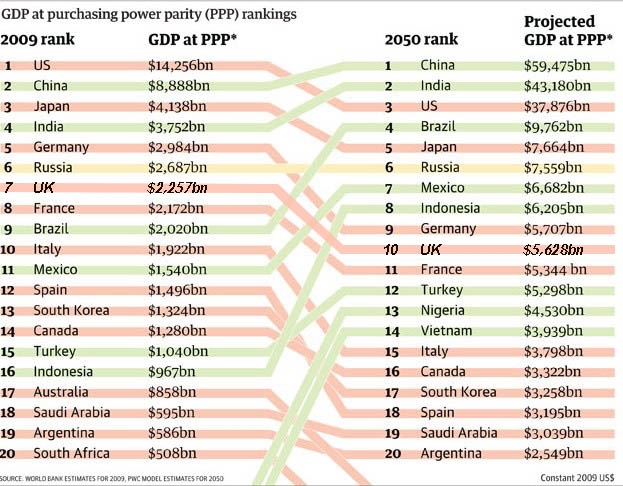“The global economy is changing, and superpower shifts”
Maybe you’ve heard that sentence so many times from various reliable sources of news. After the end of the World War II, United States of America had become a country of superpower, having so much influence towards other countries (in terms of economic, politic, and many other aspects).
However, it’s been more than seven decades since Japan surrendered to the U.S. in an American battleship on 1945, and the world’s economy is changing. If we look at the world’s GDP shares lately, the U.S. power is now declining, and there is a new powerful economy that is predicted to continue to rise, which is China’s. Although this prediction is still debatable, it doesn’t omit the fact that China’s economy is rising, at least for the last 40 years[1].

A concentrated economic activities would reduce transportation costs, which will generally increase a company’s profit and reduce household expenditure at the same time. However, to aim the best impact of a concentrated economic activites, this reduction in transportation cost should be done along with increased economies of scale and easiness of trade between areas. Then, we could explain China’s rapid GDP growth now that we know this New Economic Geography theory. The continous GDP growth in China is unsurprisingly due to its ability to do these concentrated economic activities. China’s low level of labors’ wages, which supports its large economies of scale, makes China’s export sectore one of the most successful in the world. In addition, Chinese people had done a massive migration from the center to coast areas of China. Concentrating production activities in coast areas would reduces transportation costs and makes trade activities more efficient.
To indicate the importance and urgency of reshaping the world’s economic geography, the World Bank had encouraged reshaping economic geography through its world development program, making this concern its main development goal in 2009.[3] The 2009 World Development Report suggested that in order for a country’s economy to develop, it should reconsider three spatial dimensions which are the density or geography compactness of economic activity, the matter of distance between economic activity, and the matter of divisionor trade barriers between areas. It also use few developed countries to be a sample concerning how they enhanced their spatial dimensions. For instance, taking Tokyo as a succeed example of a concentrated area, which is home to a quarter of Japan’s total population of 35 million people while it stands on just 4% of Japan’s total area.
Not only does this theory applied towards China and other developed countries, every single country in this world could also prevail this kind of rapid growth, if they succeed applying this New Economic Geography theory. That is why this theory could possibly be a single economic theory of everything, since a country wouldn’t need any other economic theory to boost its economy. However, should we fully agree on this statement?
So far, The New Economic Geography theory had only discussed the beneficial impact of this urbanization process. Thus, what about the not-really-favorable impact? If a country sets its development programs concentrated only in some areas, the people which are living in remote areas would be forced to move to those concentrated areas. As we know, urbanization often caused overpopulation and would create slums area. People’s quality of living will be lower since the competition to aim resources –water, food, energy—will increase. The number of jobs available would eventually decreased and leave many people unemployed. Also, the increasing GDP growth would not reflect the amount of pollution and damaged natural resources used to make this rapid growth happens. A concentrated area-of-living would not be beneficial for all parties after all.
The World Bank’s World Development Report, which basically forced countries to concentrate their economic activities, in fact did not provide a solution to overcome inequality that might rise due to this occation. It only advised countries’ governments to build more transportation and communication infrastructure, “synchronize efforts to facilitate the geographic transformations for the push from middle to high incomes”, and sets policies that supports inclusive urbanization, without telling what kind of policies that should be undertaken.[4]
Unsurprisingly, those advises are only concerning materialistic development, without giving attention to social and environmental aspects. At the end, this reshaping economic geography theory would not be sustainable in long-term perspective since it is only focusing on “numeral” growth. We could observe this contra theory by noticing the level of inequality and pollution in China, the country who has succeeded “applying” the New Economic Geography theory. Nowadays, China’s level of income inequality and level of pollution are amongst the highest in the world. In term of high level of inequality, China has the gini coefficient of 0.49, which made it a country with 3rd highest level of income inequality. In China, the richest 1% of households owning the country’s one of third total wealth.[5] In term of high level of pollution, the air in Beijing (one of China’s most concentrated city) was containing more than 400 micrograms per cubic meter per-December, 2016. This exceeds WHO’s safe level of air quality, which should only contains 10-25 micrograms per cubic meter.[6]
Since one of the most important government’s purpose is to promote the general welfare of its people, they should not undertake any policy that would only be beneficial for few parties, even when its purpose is to boost the overall country’s economy. Applying the New Economic Geography theory would only be acceptable if the government also consider the social and environmental cost that would rise. Making a concentrated area-of-living should be done along with reducing the gap of income inequality and maintaining sustainable natural resources. Otherwise, a country’s rapid economic growth would not improve its welfare. In conclusion, the New Economic Geography theory might be one of the best theories to improve a country’s economic growth, but it definitely isn’t the only theory we should consider when it comes to developing a country in general.








